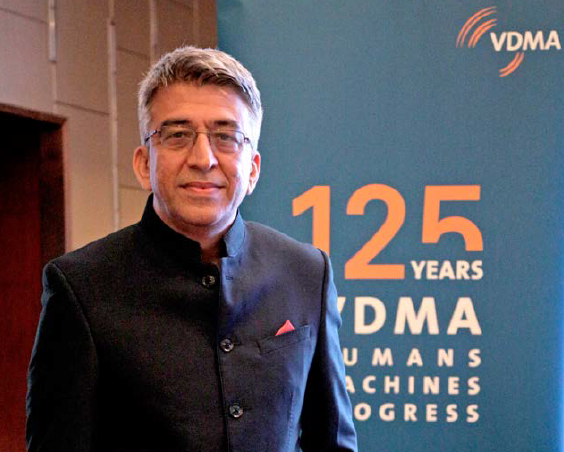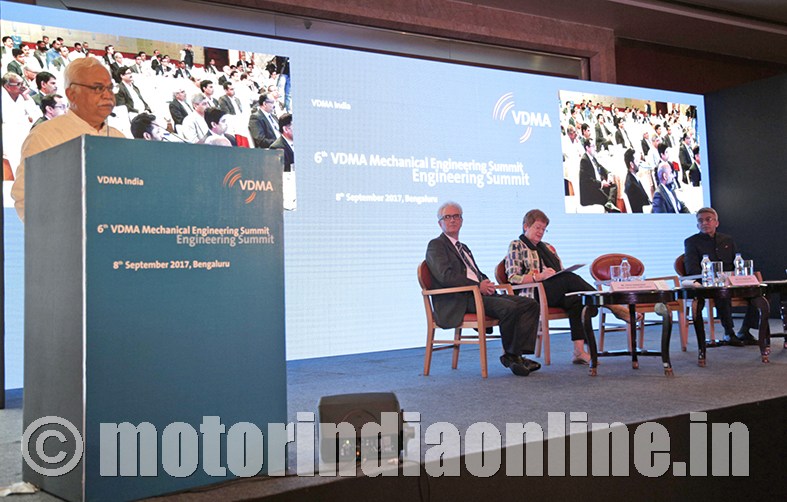‘Man-Machine Progress’ remains at the heart of Indo-German bilateral trade in a bid to offer continuous support in promoting knowledge and enhancing productivity – a thought that is echoed by VDMA. Celebrating 125 years of its conception, VDMA, i.e., Verein Deutscher Maschinenbau-Anstalten – which was founded in 1892 in Cologne in Germany with 29 machine factories, the entity today is the largest industrial association in Europe with around 3200 member companies.
VDMA India is 550-member strong and in 2017 India became the second largest sales market in Asia for the German engineering industry.
Speaking on the occasion, Mr. Rajesh Nath, MD, VDMA India Services, pointed out that, “Mechanial power transmission, textile machinery, agriculture

machinery, construction equipment, machine tools and machine handling are some of the major sectors that our member companies represent. VDMA is divided into 39 industrial verticals and many of our members are also suppliers to the automotive sector.”
Man-Machine Progress
VDMA’s 125th year celebration in Bengaluru was attended to by member companies representing 20 cities in India, supporting the spirit behind VDMA’s global motto.
Speaking about it, Mr. Nath said that, “These three are integrated because humans will lead to manufacturing machines and production of these machines will enable the processes to happen better. The concept of the seminar is to offer our members a platform to get updated about technological advancements. The summit aims to address the challenges in the manufacturing sector, and highlight the importance of machine and plant construction as a solution provider.”
The Minister for Large & Medium Industries and Infrastructure Development, Government of Karnataka, Mr. R.V. Deshpande lauded the positive reforms like GST rolled out by the current central government and highlighted the positive impact on the Indian industries, “More transparency will come with GST. India and Karnataka are brimming with the promise of Invest-Invent-Innovate.” He also urged the German Consul General to India, Mrs. Margit Hellwig-Boette, to spread the bilateral trade net wide and further out to other districts in Karnataka beyond Bengaluru.
In response, Mrs. Hellwig-Boette accepted the invitation graciously, “German SMEs are happy to be in India. Ease of business and problem solving has made it a good experience for us. We are happy to invest in other districts of Karnataka as long as the state government ensures better infrastructure and business-friendly environment similar to Bengaluru.”

delivering his special address
Key to success
Indo-German trade in 2016 grew by 0.7 per cent to 17.42 bn Euros from 17.29 bn Euros in 2015. In 2016, the total import of machinery from Germany touched a volume worth 2.97 bn Euros, which is an increase by two per cent compared to the same period during the previous year.
Indicating to the promising figures, Mr. Ulrich Ackermann, MD – Foreign Trade Division, VDMA Frankfurt, shared, “Trade relations are booming and so are the exports to Asia, especially to India. Sectors like valves, plastics and rubber machinery, power transmission among others constitute the highest share of the German engineering export volumes to India.”
Massive step in tax reforms like the GST is now yielding fruit. Talking about the impact of GST on the manufacturing sector, Mr. Rajeev Singh, Partner Consulting, Deloitte Touche Tohmatsu India, shared that, “With ‘One India’ market, every element of the supply chain is getting impacted and logistics is one area where early gains are showing.” He advised supply chain providers to take a ‘relook’ and ‘re-jig’ their value chains to lower their cost bases.
Technology as a major challenge
Globally, automotive sector adopted the technology of additive manufacturing (AM) almost 30 years ago mainly for rapid prototyping for commercial and passenger vehicle segments. Though the industry worldwide is currently undergoing a transformation, India is not yet even a blip on the radar. Industries around the world, especially automotive sector, are trying to identify serial production applications for AM.
Mr. Vishwanath Godavarty, Sales Account Manager (India, S. Asia), Materialise Software, put it into perspective, “AM is the real game changer when people start using it for producing 100s and 1000s of parts over and over again. It is about deriving benefits from product optimization for performance improvements. Right now, many countries including India are more relegated to applications and prototyping, which is good, but it does not really change the industry per se.”
‘Wait and watch’ style of business in India – to see if a particular technology adaption is successful or not when tried out by competitors may prove to be unhealthy in the long run.
Mr. Godavarty felt, “Indian industry, with regards to AM applications, works in four ways. One, there are early entrants who are still evaluating its benefits; two, those who use it in silos; three, those who give departmental level push and initiative; and four, those who have a top-down approach starting from establishing centralized departments in their companies. This is missing in India. Even with the Indian CV OEMs, it works out strange. Say, their two-wheeler department uses 3D printing, their tractor division has no idea that its sister concern is using the technology. What is needed is greater awareness, more centralized and top-down vision driven by intent. Indian automotive industry needs to benchmark themselves against the global standards.”
So how soon does he envision this approach being taken up by Indian automotive OEMs? He answered, “First question is, will it happen? Then I will ask, how soon? It is not enough to have a 5-10 year vision. It is imperative to focus on the next couple of years. Also, the Government must invest money in 3D printing. Countries like China, Singapore and South Korea have set up additive manufacturing innovation councils at the national level. Visionary approach is what is urgently needed today in India.”
He lamented the lack of awareness in small and big companies, including those in automotive sector, in knowing how to and where the AM applications fit into their businesses, calling it a ‘huge vacuum in India’.
An area where Mr. Godavarty sees AM application happening in a big way is logistics sector. He said, “The other game changer, worldwide, is when AM is applied in the logistics sector to create more on-demand manufacturing and trying to create spare parts in reverse engineering projects. This might apply more to CV than PV segments because there are low volumes in CV than PV.”
Top take-aways
Making it easier for the VDMA India members by offering latest information on industrial trends, white papers and reports that will impact their businesses, VDMA India App was launched by Mr. R.V. Deshpande, Mrs. Hellwig-Boette and Mr. Nath jointly.
Mr. Nath shared, “VDMA India App will keep the members networked in an easier manner. Our mid-sized segment companies need to reorient themselves when on the growth path because the challenges are huge and they need to know how to cope with them and come out successfully.” The App is sure to come in handy!
Adopting Industry 4.0 is for all businesses across the board. Breaking the misconceptions attached to it, Mr. Nath said, “In India, Industry 4.0 is in a nascent stage but the world over, it is in active implementation. There is a misconception that Industry 4.0 is only for big companies, but it is not so. Even mid-sized companies can implement it and reap benefits.”
Industry 4.0 is the current trend of automation and data interchange in manufacturing technologies which depends on cyber-physical systems, IoT, cloud computing and cognitive computing, in order to build Smart Factories.
The 6th VDMA Summit concluded on a positive note!